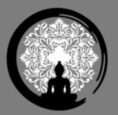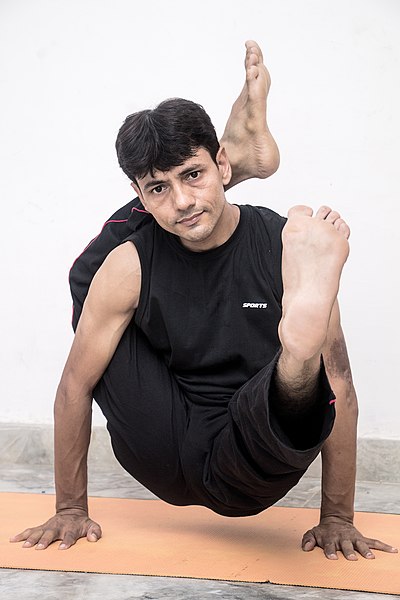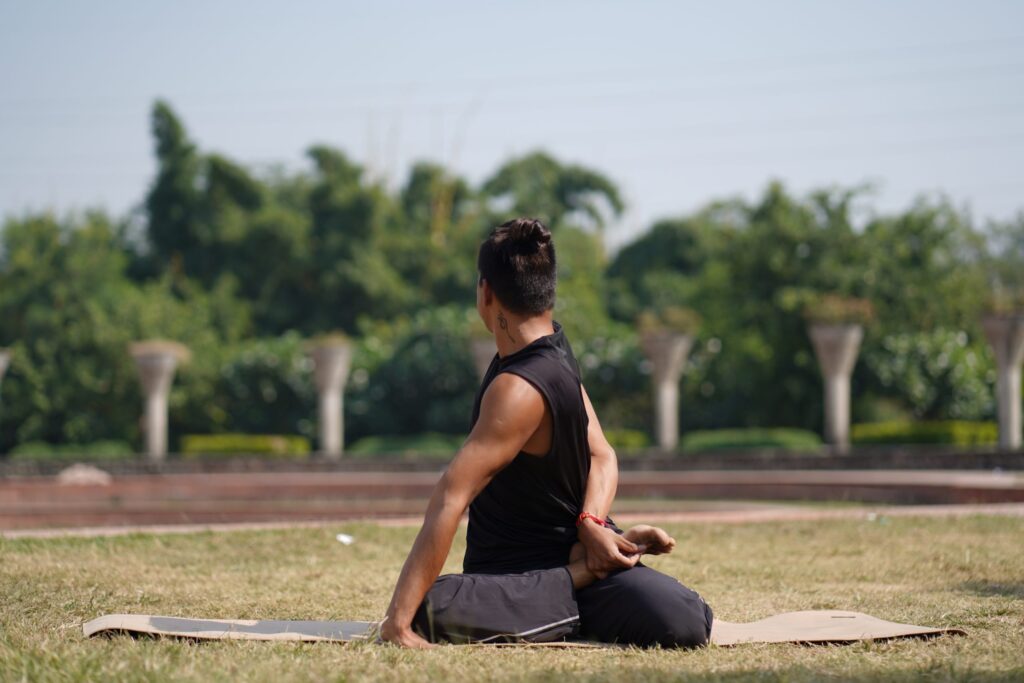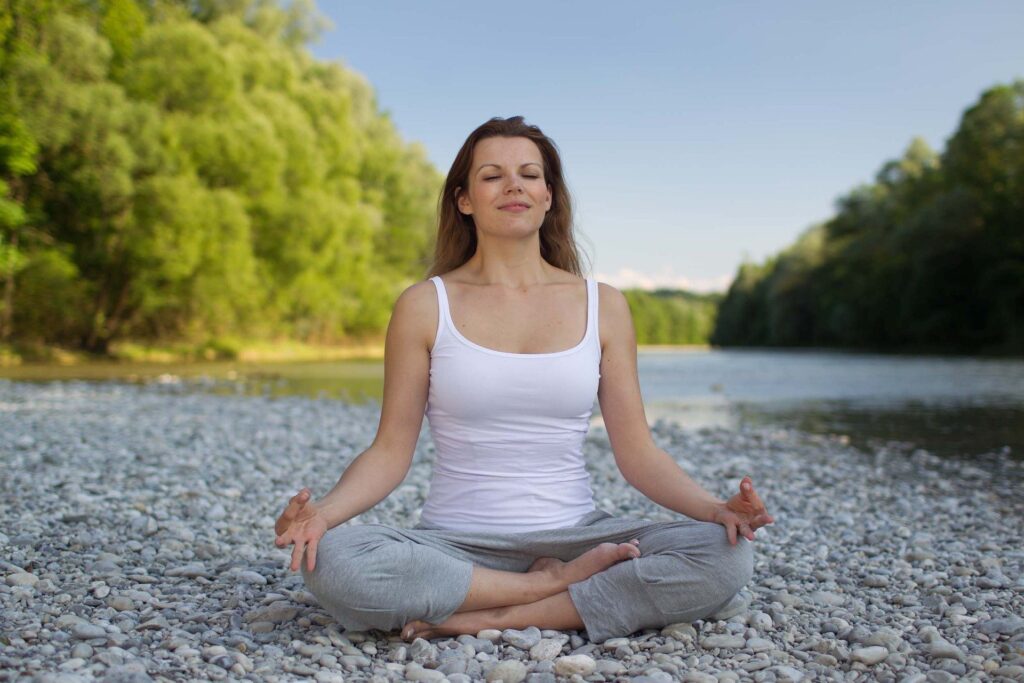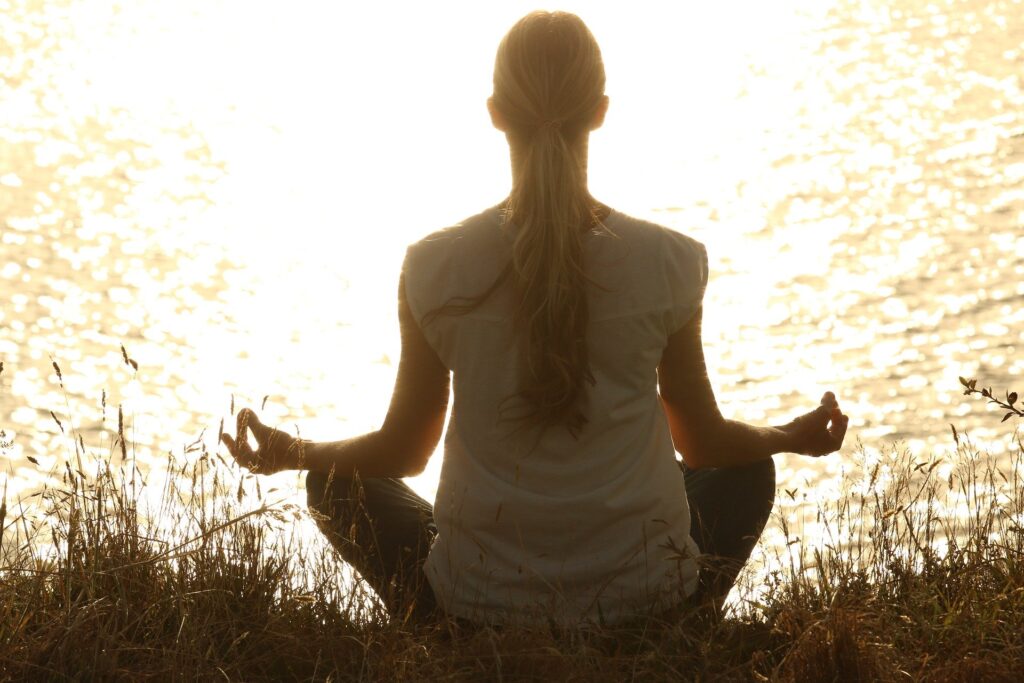Eka pada sirsasana ( एक पद शीर्षासन ) is commonly known as ‘Seated foot behind the head pose‘ or One Leg behind the Head Pose. This challenging asana is part of Ashtanga yoga that strengthen your neck, back, legs, hips and hamstrings. Here, we’ll talk about various such benefits, steps and precautions for performing ‘Eka Pada Sirsasana’.
The Sanskrit name, Eka pada sirsasana is the combination of four words ‘Eka’ ( एक ) meaning ‘one‘, ‘pada‘ ( पद ) means ‘foot‘, sirsa, ( शीर्ष ) meaning “head,” and ‘Asana‘ ( आसन ) means ‘pose’. In this seated posture, a yogi need to join his hands in Anjali Mudra with one of the foot rests behind the head where the leg over shoulder looks like a backpack.
Eka Pada Sirsasana is an advanced yoga pose that is often associated with Anahata Chakra, Ajna Chakra and Muladhara Chakra. These Chakras helps to improve concentration, increase stamina & surges the feelings of love, compassion and deep awareness.
Eka Pada Sirsasana is a complex exercise that demands combination of strength, flexibility, patience and mental persistence. During this posture, your leg exerts pressure on your neck that needs to be balanced with the strength of the neck and back muscles.
How to do Eka Pada Sirsasana or Foot Behind the Head Pose
Following are the step – by – step instructions to follow for the practice of Eka Pada Sirsasana ( Foot Behind the Head Pose ) :
Step 1 :
- Sit upright in Dandasana with both legs extended straight in front of you and palms near your hips.
Step 2 :
- Slightly bend your right knee, bringing sole of the right foot to the ground in line with the left knee.
Step 3 :
- Raise your right foot from the floor opening; your hip by holding your right ankle with the left hand.
Step 4 :
- Bring the right shin towards the chest and rotate right thigh to pull right ankle towards Ajna Chakra.
Step 5 :
- Draw right knee out to your right side so that the right shoulder to fit beneath your knee and thigh.
Step 6 :
- Here, right shoulder should move forward & the right leg moves backward on top of the shoulder.
Step 7 :
- Tuck right ankle behind the neck and left shoulder meanwhile other leg lie straight in front of you.
Step 8 :
- You can also use left hand to work the right calf down the upper back to reduce pressure on neck.
Step 9 :
- Raise the chest upward away from abdomen and head pressing the back of your head into ankle.
Step 8 :
- Place your sitting bones on the floor firmly and join both hands in front of the chest in prayer pose.
Step 9 :
- Hold the final position for 30 – 60 seconds and gently release the pose by unfolding your right leg.
Step 10 :
- You can use hands for lifting leg from behind the neck then keep the hands on the floor near hips.
Step 11 :
- Follow the above steps of Ekapadasirsasana with your left leg as well for the same amount of time.
Modifications and Variations
Supta Eka Pada Sirsasana and Urdhva Mukha Eka Pada Sirsasana are variations of Eka Pada Sirsasana or One Foot behind Head Pose.
To deepen your experience during Eka Pada Sirsasana, try these following modifications and find the variation that works well for you :
- You can use a wall for support if in case you’re suffering from any back problems or face difficulty in holding the asana.
- If you can’t hold the final position with your hands in Anjali Mudra, then you can keep the hands on floor near your hips.
Precautions and Contraindications
Following are some precautions you should keep in mind before you start doing Eka Pada Sirasana or One Foot Behind the Head Pose :
- Avoid the practice of Eka Pada Sirsasana if you are suffering from sciatica, hernia or have tight hamstrings.
- You should strictly avoid this asana if you have pain or injury in the knees, spine, hips, neck, ankles or back.
- You should go slow and steady while performing Eka Pada Sirsasana else it may lead to strains or injuries.
Health Benefits of Eka Pada Sirsasana – One Foot Behind the Head Pose
Following are the Five Major Health Benefits of Eka Pada Sirsasana, that you would acquire gradually with its regular practice :
This pose aids to improve your strength, flexibility, endurance, digestion, blood flow, self awareness and sub–consciousness.
1. Eka Pada Sirsasana improves the Muscle Strength
- Ekapada Sirsasana is an excellent exercise that helps to build strength in the neck, back and spinal muscles.
- Its stretching effect not only makes the back strong and flexible but also helps to reduces pain and stiffness.
Also Read :
2. Eka Pada Sirsasana helps to increases Blood Flow
- Daily practice of One foot behind the head pose help to improve the blood circulation throughout the body,
- This increased flow of blood enrich level of hemoglobin that treats anemia and remove accumulated toxins.
Also Read :
3. Eka Pada Sirsasana nourishes your Nervous System
- Eka Pada Sirsasana is one of the best asana for people who are suffering from nervous trembling problems.
- The pose improves focus on breathing that results in nourishing brain nerves, reduces fatigue & stress level.
Also Read :
4. Eka Pada Sirsasana corrects the poor Body Posture
- Regular practice of Ekapada sirsasana improves your body balance by keeping the spine in upright position.
- The external rotation of the posterior during this pose results in the intense opening of hips and hamstrings.
Also Read :
5. Eka Pada Sirsasana helps to improve your Digestion
- By performing this pose daily your core region get toned that’s useful for people with poor digestive system.
- Besides this, One foot behind head pose helps to activate the digestive fire that helps to digest food quickly.
Also Read :
Preparatory Poses
- Supta Padangusthasana
- Kurmasana
- Sirsasana
- Sarvangasana
- Anand Balasana
- Paschimottanasana
- Akarna Dhanurasana
- Agnistambhasana
Follow up Poses
- Chakrasana
- Ustrasana
- Setu Bandha Asana
Tips For beginners
- Eka Pada Sirsasana is an advanced level asana so always practice some warm-up exercises before you start practicing this asana.
- You can practice Eka Pada Sirsasana both in morning and evening with at least 2 hours gap between your meal and your practice.
- If you feel unbearable pain or strain in your body while performing Eka Pada Sirsasana, you should immediately release the asana.
- If you’ve any medical conditions, always consult your doctor first and practice it under the supervision of an certified yoga teacher.
- You should be focusing on the breathing pattern and try to make it slower, deeper and steady as you maintain Ekapada Sirsasana.
Conclusion
Eka Pada Sirsasana offers numerous health benefits – stimulates digestive fire, makes hips and legs supple, useful for diabetic patients, improves blood flow, detoxifies body, make sitting bones flexible, cures hay fever, improves elasticity of body etc.
We really hope that this article would be useful guide for your practice of Eka Pada Sirsasana. Try out this excellent asana to get a flexible body and do share your thoughts, views and suggestions on this blog post in the comment section down below.
Also Read :
FAQs related to Ekapada Sirsasana and its Benefits
Do the practice of Eka Pada Sirsasana help to improve Mental Health ?
Eka pada Sirsasana lowers your heart rate, improves deep breathing and reduces stress hormones. This improved and controlled breathing calms your mind. relaxes heart muscles, treat asthma and ensures balanced blood pressure. Plus, it also helps in management of anger, anxiety, migraine & headache.
How can the practice of Eka Pada Sirsasana make your body flexible ?
The practice of Eka Pada Sirsasana strengthens lumbar and thoracic regions, increases mobility of hips and legs, stretches and lengthens your calves, spinal cord, hamstrings, glutes, psoas and hip flexors. It is a powerful restorative and rejuvenating asana helps to release backache and stiffness from the body.
